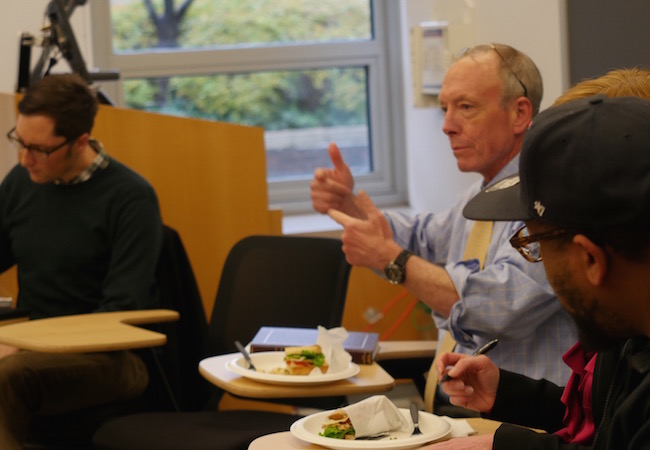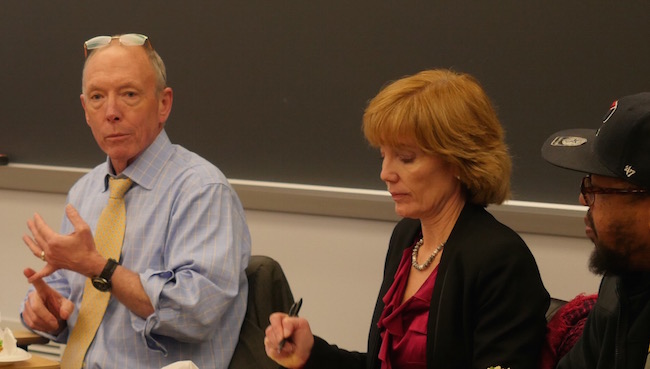U.S. Under Secretary of Education visits Penn GSE

Ted Mitchell, Under Secretary of Education in the Obama administration, said he would answer anything.
It was mid-December, and Mitchell stopped by Penn GSE during a trip through Philadelphia. For more than an hour, he candidly answered questions from about 20 doctoral and master’s students on how higher education policy gets made, the challenges facing colleges, and making progress amidst partisan divide.
Noting that President–elect Donald Trump hadn’t made higher education policy a priority during the campaign, one student asked Mitchell how he and his peers — many aspiring to work in college administration — could put pressure on the incoming administration to focus on student access to higher education.
Mitchell urged pragmatism and suggested focusing on the intersection between higher education and the President-elect’s priority of bringing back jobs.
“I think making the point over and over again, if you want to bring jobs back to people who lost them in the de-industrialization of the Rust Belt, what are your options? OK, so let’s invest in higher education,” Mitchell said.
“It seems to me that putting ourselves in the solution set for things that the administration identifies as problems they want to solve is the likeliest way for all of us to get a hearing. And I think that would be true with any administration.
“I hold out the great hope that America’s College Promise gets renamed and gets used as a tool to make lots of great jobs at the local level.”

Here’s the rest of Mitchell’s conversation with the students, edited for brevity and clarity:
Q: What do you see as the most pressing issues for the future of higher education?
A: If you take this problem of increasing the throughput of people who don’t typically go to college in America, it doesn’t make intellectual sense to say if we keep doing what we’ve done in the past we’ll reach those people. Using technology and new kinds of innovation to create new avenues to higher education for the ‘new normal’ student I think is the work, and we’ve just started to turn the dials.
We’re still figuring out how to harness innovation and service students well who come with very different profiles.
The direct loan program was a remarkable change. The majority of private loans shifted to the federal government. For the most part the program worked, but it needs to be improved.
I think we now need to move higher up on the food chain and work with accreditors to really take student outcomes seriously. This isn’t the federal government deciding outcomes. It’s working with regional accreditors to say, what are the standards you hold your institutions to? Some of them will leap over those standards. Others will really struggle. You (the accreditor) should spend all of your time with those that are struggling and stop spending time making [top performers] go through incredibly rigorous and not very meaningful work.
Q: Who was involved in making the decision to curtail Parent Plus loans? Did the department reach out to any Minority Serving Institutions (MSIs), Historically Black Colleges and Universities (HBCUs), or representatives of low-income students of color about how it would affect them?
Editor’s note: The U.S. Department of Education created stricter requirements for Parent PLUS loans to try to stem the relatively high rate of defaults. But the measure was criticized by many for cutting off a source of funding for many students who needed it most, and harming colleges — especially Minority Serving Institutions — where many students relied on a PLUS loan to finance their education. The department later reversed its decision.
A: We screwed up on the Parent PLUS loans. And in part, we screwed up because we didn’t have the prospective process in place to really test out the kind of impact it would have.
We realized pretty quickly we made a policy mistake and we stepped away from it. We also changed the way we do policy. Now, we always, always, always, ask how is this going to affect MSIs? How is this going to affect HBCUs? Who are the folks we go to talk to about this?
Q: What can be done to make sure more students graduate high school prepared for college?
A: This is why we supported states’ efforts to create a Common Core curriculum that was much more aligned with what colleges were asking for. I was the chairman of the school board in California when California passed the Common Core, and that was the reason it passed.
I still have great hope — states have developed their own version of Common Core and I think that will work its way through the system. In the meantime, I think we need to double down on remediation, and have new and better ways for students to remediate while they’re getting college credit or before they’re getting college credit.
Q: Republicans have control of most state houses in the country. Do you see areas where progress can be made in access and affordability even though people might disagree with your politics?
A: As a general political point, I’m a complete amateur, so take this story for what it’s worth. I’ve found, in general, party labels matter less the closer you get to the ground where people are living and working. So for example, we’ve had some of our very best conversations about College Promise with Republican representatives from Alabama. It is kind of counterintuitive, but they need to create real jobs for people, and community colleges have their eyes on the labor market needs in ways that the state university doesn’t.
I think there are bargains about real people doing real work that are achievable in almost every state … I actually have a lot of hope that in local communities and states, things will continue to progress not because of any ideological predilection, but because the things they have to solve can’t be solved by ideological predilection alone.
Q: How can technology make college accessible to more students?
A: I think there are a couple of domains where technology can improve student outcomes. One is using data better at an institutional level. Identifying pathways for students that are productive versus unproductive. Helping students manage their course load, especially in community colleges. Helping students understand, even at a micro level, that there are certain paths of courses you should take and some you shouldn’t.
I do think we have new delivery modes that are more accessible: asynchronous video embedded in computer instruction can make it easier for people who just can’t be in a classroom at a [particular] time. Embedded in that are new ways of assessment that assess learning, not just proxies for learning. That’s still under development.
Q: What is the role of research, the role of advocacy, and the role of politics in developing policy? What actually gets through?
A: Those three shift in terms of importance depending on the issue and, frankly, who has the right idea. In my experience in the department, advocates play an enormous role in raising problems to the level of action.
We mine research for folks that have tried to identify something that is either this problem or looks like this problem, where did it come from, and why does it persist. There is a sort of sequestering of policy analysts who put together their best hypotheses for what we do as a federal government with the tools we have.
There are always the voices who want to get politics in, but that really doesn’t come until the last phase.
Q: As we get ready to start our careers, what should we be thinking about?
A: Strategize but don’t be a slave to it. Make sure you’re prepared for the broad path you want to be on, but don’t have it be so narrow that you say no to opportunities that could give you a vantage point you wouldn’t otherwise have.
